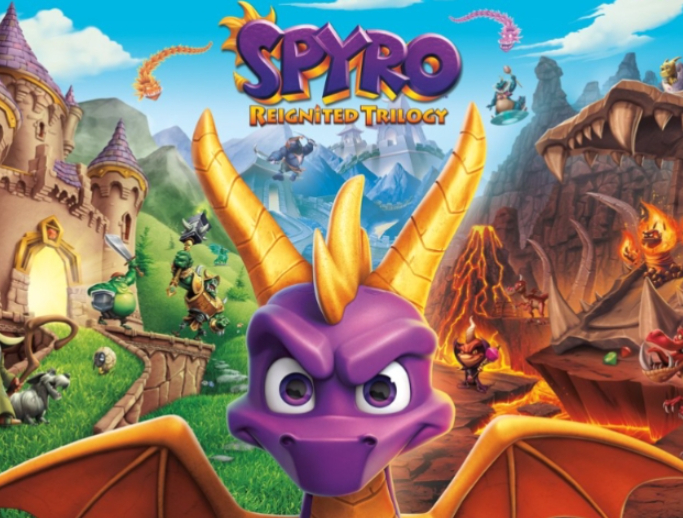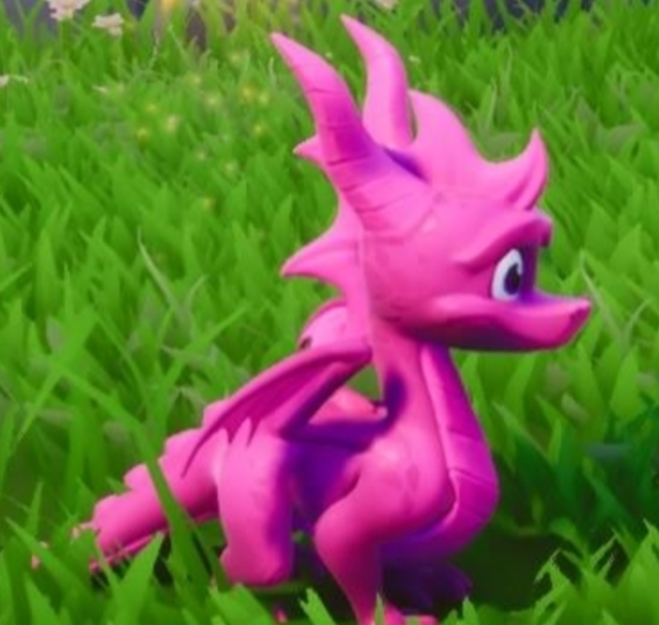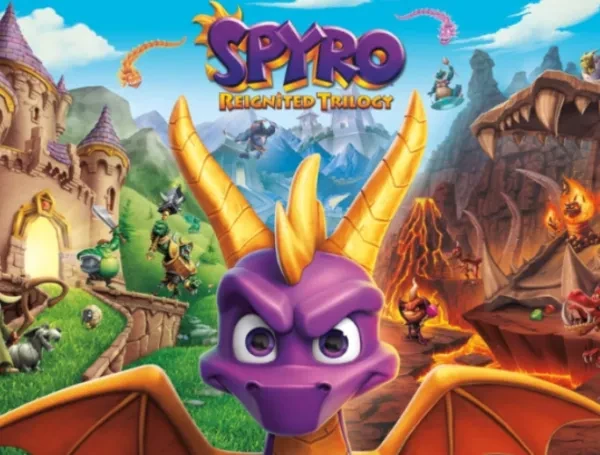
Spyro Reignited Trilogy: The Good, The Bad, The Ugly
The Spyro Reignited Trilogy was created by Toys for Bob in the year 2018. It’s a remake of an older game, released in the later 90s, originally made by Insomniac Games for the PlayStation 1, and to this day still has a massive following of nostalgic dragon-loving gamers who have been around since the conceptualization of 3D Platformers. Each game in the trilogy brings its own beauty and uniqueness to the franchise, and while each one is special in its own right, one is definitely better than the other two and one is not as good. But if they’re all so great, what makes them so different?
3rd Place: Spyro 2: Ripto’s Rage
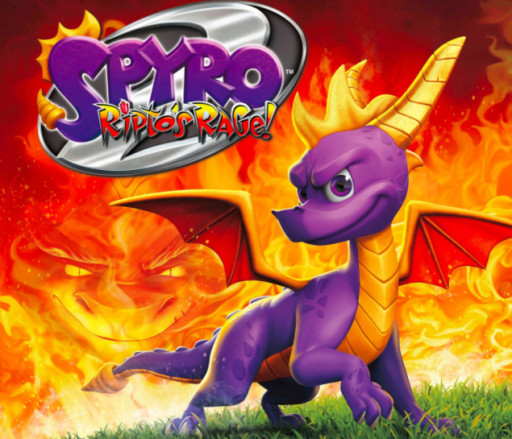
Spyro 2 Reignited's Take On The Original Spyro 2 Cover
Spyro 2 Reignited Full Gameplay Walkthrough
Spyro 2 is by no means a bad game. It’s beautiful, it’s fun, it adds a lot that would become a big part of the series. Ripto’s Rage added new main characters, a new antagonist, multiple new mechanics, and retained the beauty and music that stuck out so well throughout the first game. But if it added these mechanics which were a good addition to the game, why is it the lowest of the trilogy?
What Spyro 2 Did Right:
Spyro 2 starts off strong by setting the stage with new characters and new worlds, giving the plot and all previously mentioned information in just a 3 ½ minute cutscene. It’s also quick to explain new mechanics such as swimming, a small gliding upgrade, and the new collectible: orbs.
The way in which you obtain most orbs is by completing minigames or challenges throughout the new region of Avalar, which is a neat addition to the basic “grab gem, touch dragon” of the previous game. Another neat addition with the collectibles was that gems weren’t just collectibles, but currency in which you would use to pay for certain passages to be opened up and as well as obtain a few abilities.
Spyro 2 also introduced multiple characters for each world you traveled to, usually having the same design as everybody else in the world, but having a different voice and color palette. This brought a little more life to the world you were traveling through, and every new world you went to was accompanied with a cutscene for entering the world and leaving it.
These additions made Spyro 2 a very well done successor to Spyro The Dragon in the Reignited Trilogy, but sadly it was missing a few things that made the first game so magical. So with the introduction of characters, worlds, currency, orbs, and minigames, what was missing? What makes it a good sequel, but not a great one?
What Spyro 2 Did Wrong:
Spyro 2, despite its advancements, also took steps back that made it fall short of some of the amazing beauties of Spyro The Dragon. A lot of that comes with additions working as replacements. The new orbs were a good addition, but they came with a drawback.
Orbs are scattered everywhere throughout Avalar and if you’re properly exploring and not just charging through levels like a dragon on skooma, then you’re likely to come across them even by accident. Orbs are used to progress through the game, so you need to be collecting them semi-regularly to open up new levels. However they aren’t the main objective despite how important they are, the new main objective is to simply complete every level and you’ll be rewarded a talisman. But this requires you to complete every single level (excluding the flight levels).
Orbs, Talisman, and Gems replace the dragons from the first game, and they’re all quite boring. The dragons were so beautifully designed, named, and all of which Spyro interacts with and talks to. The people who give you orbs and talismen? Spyro says nothing, not to mention that even though there’s new designs for each character you talk to in each new world, almost all of them are quite obnoxious.
Spyro 2 also introduced swimming as a mechanic as well as headbashing and climbing. Swimming brings in a whole new way to traverse that isn’t a flight level, whereas climbing and headbashing are only really used selectively. They’re neat additions, but don’t really change what you’ll primarily be using to get around and defeat bad guys. A for effort, C- for execution.
The headbash mechanic can be used as a way to defeat enemies and is the only way to defeat a small handful of them, but it does serve another purpose and that is to obtain gems from canisters that require you to headbash. This new way to earn gems replaces the mechanic from Spyro 1 where you would have to obtain a key from time to time and go unlock a chest, which was often a pretty interesting (yet short) scavenger hunt.
Finally, Spyro 2 did not implement any traversal challenges. In the first Spyro game, sometimes you would have to Supercharge across crazy paths in a very specific way to get to places you wanted to be in order to 100% the game, or you would have to fly off to corners and pillars you couldn’t initially see, and think ahead of what’s right in front of you. Spyro 2 may have had a couple of difficult flight spots, but all around the mechanics of flying and supercharging were very underwhelming in comparison to the previous game, and thus fell short.
And that is why Spyro 2: Ripto’s Rage is placed at the bottom of the Spyro Reignited Trilogy. It is not a bad game, though! It is very fun and full of interesting things and plenty of improvements that the first game needed without it even being obvious. So despite its placement, it is still a wonderful game.
2nd Place: Spyro The Dragon
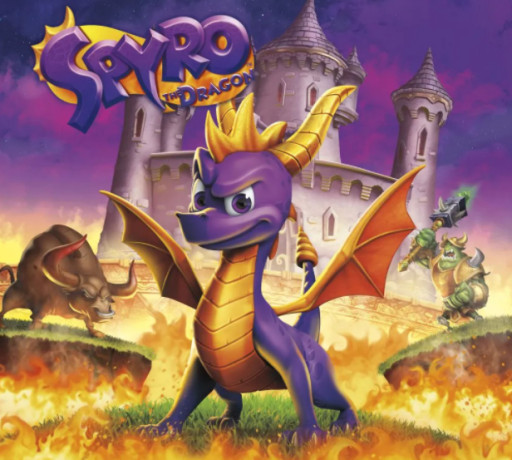
Spyro 1 Reignited's Take On The Original Spyro 1 Cover
Spyro 1 Reignited Full Gameplay Walkthrough
Spyro The Dragon, or Spyro 1, takes place in Spyro’s home, the Dragon Kingdom. The game starts off with a brief cutscene that introduces Spyro, the plot, and the antagonist. It even alludes to the entire game’s goal, traversing the 6 worlds and collecting 14,000 treasure. Spyro 1 is an original game with tons of charisma and flair that neither of its sequels in the trilogy were able to recapture. Spyro 1 is much more simple than the other two games, so what did it have that Spyro 2 didn’t?
What Spyro 1 Did Right:
Spyro 1 features plenty of mechanics that make a game…well, a game. Collectibles (and 4 different kinds), platforming, enemies, challenges, all sorts of things. It was never meant to be a complex game and it stuck to it at its core, while occasionally throwing in some crazy difficulty for the people who wanted to 100% the entire game.
Spyro’s main goal throughout the game is to save the Dragon Kingdom from the crystalizing curse of Gnasty Gnorc, the game’s main antagonist who’s turned all of the dragons (except Spyro for some reason) into crystal statues because a dragon called him “ugly” and “simple” on television. So your goal is to save 50 of them, collect 10 dragon eggs, and 6,000 gems in order to face Gnasty Gnorc, and that's the minimum requirement. That may seem like a lot of collectibles, and it is, but that’s the beauty of the game.
In Spyro 1, you don’t have to complete every level. You don’t have to get from the beginning to the end, you just have to free enough dragons and pick up as many gems as you can along the way. There’s no Talismen and Orbs to collect, you can just speed through every single level and enjoy it. But Spyro 1 all in all has better collectibles, and not just because you can get through it faster.
Every dragon you free has its own design (actually 74 out of 80 have an original design, there are 6 you free twice). Every dragon has his own name, a voice, and Spyro talks to almost every dragon as well. The dragons are fun because they have life within them, and they’re not these obnoxious fools who think weird green orbs are cheese balls. They are friendly, they are wise, and they get a reaction out of Spyro, as opposed to the entirety of the NPCs in Spyro 2 and 3.
Spyro 1 also has traversal challenges which require you to either fly blindly to locations that are tucked away or far in the distance, but it also has Supercharge challenges. Supercharging makes you run crazy fast and it makes you invincible, and while it’s featured in Ripto’s Rage, it’s not used as a puzzle.
Spyro 1 also had this strange beauty to it that the other 2 games didn’t replicate. Everywhere you went it felt like there was magic in the air, in the music, and in the world. The entire place felt vibrant and glowing, and neither Spyro 2 nor 3 did that properly. Spyro 2 did give its homeworlds a similar feeling, but only the homeworlds. In Spyro 1, every level had its own personality whereas despite the diversity of levels and setting in the other 2 games, it all still feels kind of the same.
What Spyro 1 Did Wrong:
Clearly I have a bit of bias for the first Spyro game, but I won’t enjoy something without seeing it through a critical eye. Spyro The Dragon does have flaws, but some of these flaws aren’t readily apparent until you see what was added to its formula in the following games.
Spyro 1 is very repetitive. I mean very. It does a good job at hiding it by making every world feel so different than the previous, be it through layout or scenery. It masks repetition with diversity in a very clever way, but at the end of the day, it’s just nonstop run and flame. Spyro 2 changed this by adding in some side objectives and minigames that you can do and have to do, which is where the first game fell short.
Continuing with repetition, Spyro also lacks a move set. You can glide, but it doesn’t exactly do much for your combat. You flame and charge, and that’s it, and even the powerups you get throughout the game only make your flame and charge temporarily stronger. It’s still the same thing. While there are flight missions which sort of change up the gameplay, they’re incredibly short and after you do it once there’s not much reason to return.
Spyro 2 and 3 both added to these, adding additional abilities and even characters, in both land and air levels. So while not every addition was perfectly implemented, it was necessary, and was a good way to push forward the Spyro gameplay.
Finally, the collectibles. There are so many collectibles. I find it fun, personally, but not everyone does. Collectathons are not for everyone and I totally get it. All three Spyro games in the trilogy are collectathons but Spyro 1 made it the best of the trilogy and the worst at the same time by making collecting interesting, but also there’s just so much to collect. As I mentioned before: dragons, gems, eggs, and keys.
Despite its ups and its downs, Spyro The Dragon ranks second. Spyro The Dragon is my favorite of the trilogy, but that’s based on personal preference. I can see when things have been added for the betterment of a game, and in this case, Spyro 2 and 3 added better things, just Spyro 2 took away too much. So how did Spyro 3 fix what Spyro 2 messed up?
1st Place: Spyro 3: Year of the Dragon

Spyro 1 Reignited's Take On The Original Spyro 1 Cover
Spyro 3 Reignited Full Gameplay Walkthrough
Spyro 3: Year of the Dragon starts off…weird. The opening cutscene starts with Spyro, Hunter, and a few other dragons all asleep on ground, surrounded by eggs, in the middle of the Artisan’s homeworld, specifically Stone Hill. Suddenly holes appear in the ground and the main antagonist’s minions come in and begin stealing the eggs, and while this is all fine and dandy, it will never not bother me that everyone is just sleeping in the grass in the middle of the day outside, and Hunter is there too, and somehow Hunter makes the most sense sleeping in that weird scenario. Still, despite its odd beginning, Spyro 3: Year of the Dragon is number 1 for a reason.
What Spyro 3 Did Right:
Spyro 3 introduced a number of things that bettered both games' core aspects. In fact, the game didn’t take away a single mechanic and simply added on. Orbs are no longer a collectible and neither are talismen, but instead both are replaced by Dragon Eggs. When it comes to collection, a core gameplay feature of Spyro, this game takes the cake when it comes to implementation into gameplay.
You obtain eggs through the same way you obtained orbs and talismen in the previous game, immediately fixing the issue that was in Spyro 2. You no longer have to complete every individual level. You’re free to skip levels if they may be too much of a challenge or if you simply don’t like them. Dragon Eggs fix an issue that both games had.
Dragon eggs being 1 of 3 collectibles (Eggs, Gems, and Keys) introduces a slew of positivity. There’s no longer 4 major collectibles as there were in the first game, you don’t have to play every single level, and every time you collect an egg, it hatches! This gives you the opportunity to somewhat “meet” a baby dragon, and while there’s no real interaction between Spyro and said dragons, it’s much more interesting than orbs and talismen, and it feels like a fair callback to the first game.
Along with eggs, you also get the introduction of keys again, a minor element still and not necessary if you’re just playing to get to the end, but it’s a welcome reintroduction. Keys are used to open boxes that are filled with gems. That’s not the only thing that returned, though, traversal challenges also return, though in lesser numbers.
An actual addition that isn’t just brought in from an old game is new characters! You get the opportunity to play as Sparx, Sheila the Kangaroo, Sgt. Byrd the Penguin, Bentley the Yeti, Agent 9 the Monkey, and Hunter the Cheetah (but only in flight missions sadly). All characters come with their own unique levels and move sets, spicing up the gameplay in more ways than one.
Spyro 3 also decided to get rid of the cutscenes upon entering and exiting levels, and while this could be seen as a downgrade, the cutscenes did tend to slow down the gameplay. The new characters along with every level are still there and can be rather…unintelligent, but they’re much less obnoxious than they were before! So this is a plus in my book.
Spyro 3 didn’t add any new move sets, though, it did add new flame abilities which are typically only available in certain missions. Spyro 2 did include this aspect as well, but it was much more limited. In Spyro 3, your breath feels significantly more powerful than just a bit of fire coming out of your mouth, a problem both games had. Spyro 3 also introduced skating challenges, which may or may not confirm that Tony Hawk is an anthropomorphic hawk in this universe. The skating challenges serve as another break from the action in the same way flight missions do. It’s another set of moves and, if you don’t like them and don’t care about getting 100%, you don’t have to play them!
What Spyro 3 Did Wrong:
Spyro 3 did so much right, it’s hard to imagine that there’s anything wrong with it, but it suffers from some of the same issues that Spyro 2 did. Spyro 1’s magic is just so hard to capture with all of these elements brought into the fold, you can’t help but see that it’s losing the simplistic nature that made it such a beautiful game in the first place.
That being said, what it did wrong is simple. Just like Spyro 2, it lacked that magical atmosphere that the first game had (though that’s arguably fitting as the game is about restoring magic to the world with the baby dragons, so the fact that there isn’t any…). It also lacked a lot of interaction with Spyro himself, which is the biggest disappointment because not only is the game called Spyro, Spyro is the most interesting character!
Besides that, the game also feels much harder than the other two, which isn’t necessarily a bad thing. The other two games were very easy, and seeing as this game was quite difficult and very long in comparison to the other two, it certainly makes for more time to play it. Though if you go in treating it like Spyro 1 or 2, you’re gonna have a rough time.
And finally, collectibles. The best part of the game is also one of the worst parts. While it does a good job of managing the collectibles and making each one worth it, there’s also so many collectibles quantitatively. There are 150 eggs and 20,000 gems. The game is longer than the previous two, so it makes sense, but if you are not a fan of collectibles, then don’t even think about 100% on this game!
Conclusion:
That is why Spyro 3: Year of the Dragon is the best Spyro game in the Spyro Reignited Trilogy, even if Spyro 1 is my favorite. Please don’t forget, though, that all three games are fun and wonderful, and if you haven’t gotten your own copy of the trilogy yet, you definitely should. It’s hours of fun, and even more for completionists!
You may also be interested in:
- Is Spyro Reignited Trilogy Worth It? (Here's 15 Things You Should Know)
- Games Like Spyro Reignited Trilogy (Games Better Than Spyro Reignited Trilogy Better In Their Own Way)
- Spyro Reignited Trilogy: Which Is The Best Game in The Trilogy?
- [Top 10] Spyro Reignited Trilogy Cheats Every Player Should Know

